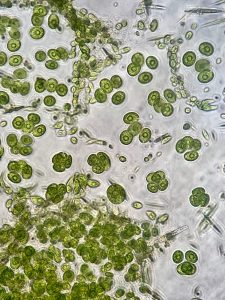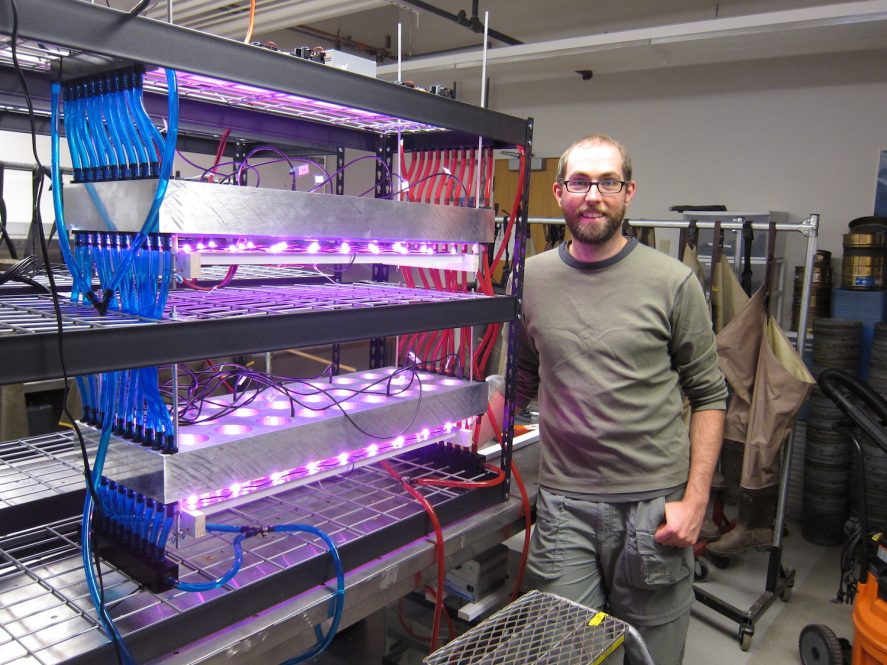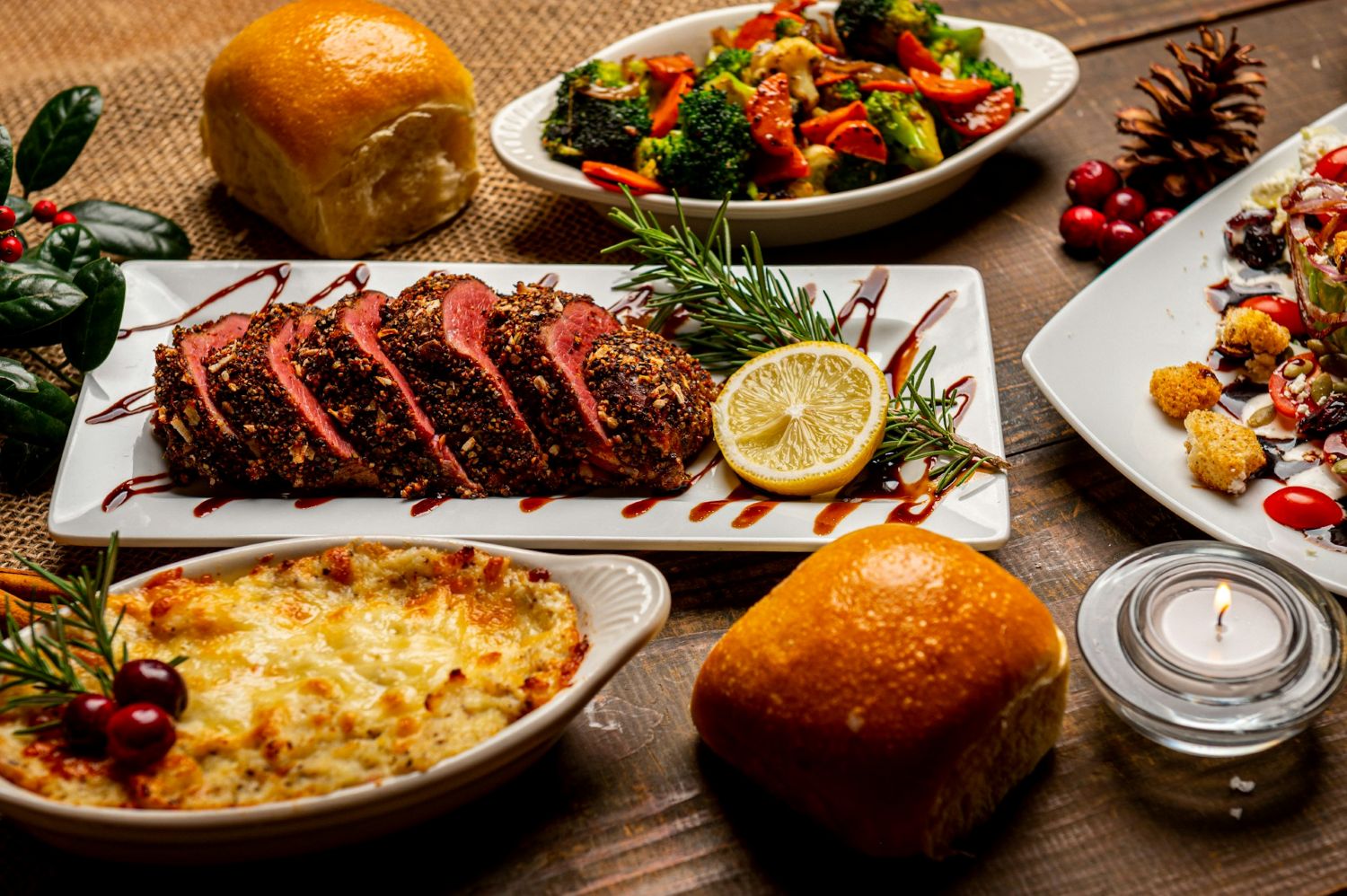Single-cell plants called phytoplankton have a surprising way of remembering conditions in the past to help jump-start their growth in the future, but no one is sure exactly how they do this.
Researchers, including UConn Department of Ecology and Evolutionary Biology Assistant Professor Colin Kremer, David Anderson of the University of Hawaii, Samuel Fey and Hannah Meier of Reed College, and David Vasseur of Yale University, detail their mechanistic theory of how this phenomenon, known as phenotypic memory, works in phytoplankton in their paper published in PNAS and supported by the National Science Foundation.
Though small, phytoplankton are hugely important because they make about as much oxygen globally as all of the oxygen-producers we usually think of like trees and grasses, says Kremer. Phytoplankton are abundant in lakes and oceans and besides acting as vital oxygen creators, they also play significant roles in global nutrient cycles and ecosystems, therefore understanding the conditions that impact their productivity is vital.
“We’re particularly interested in how they are affected by abiotic conditions, like the amount of nutrients available in their environment and temperature, because that influences how quickly they can grow, and where different kinds of species can occur,” says Kremer.
In recent years, researchers began to realize that predicting phytoplankton growth rates is not as straightforward as simply considering current growing conditions, says Kremer, and that past conditions also play a significant role in current growth through phenotypic memory.
“We wanted to understand how it’s possible for them to do that,” says Kremer. “They don’t have brains, so how does this past information influence their performance?”

Kremer and his colleagues wanted to dig into this question and develop a mathematical model to help predict the growth of these important organisms. Knowing these details can help predict how quickly phytoplankton populations grow, how they convert solar energy to biomass for food webs or biofuels, and in the case of some species, predict the location and intensity of toxic algal blooms.
Fey and Meier grew different species of phytoplankton under controlled temperature and light conditions. To manage this, Kremer says he, Vasseur, and Fey built thermal gradient blocks to use space more efficiently while also carefully altering the growing conditions for the many test tubes of phytoplankton they were working with.
“We grew the phytoplankton in test tubes at different temperatures and then manipulated their past and present conditions by moving the test tubes to different places along that block,” Kremer explains. “Then we measure their growth by looking at how much biomass accumulated over time.”
In the paper, lead author Anderson detailed the development of a mathematical theory to describe the mechanism of phenotypic memory. He also compared the experimental data to the theoretical model and Kremer says they were excited with how closely the relatively simple model captured the data they collected in the lab.
“A lot of the work that I do involves trying to develop mathematical and statistical models of how things in ecology work, and very often it’s difficult to fit those mathematical models to experimental data. It’s often a real struggle, and in this case, the model just fit beautifully really early on,” says Kremer.
“We were initially surprised by how well this model predicted the observed data because it’s relatively simple– but often in ecology, the key is to find the sweet spot between needing to measure and understand dozens of biochemical pathways to obtain an accurate predictions for a single species, versus understanding a few key processes to understand how major groups of organisms will respond to their environment,” says Fey.
They found that the ability to store nutrients for future biomass production is integral and determines how quickly phytoplankton can grow.
“The easiest analogy we’ve come up with for this is if you think about a phytoplankton growing in water that’s fairly cold, its ability to grow is fundamentally limited by temperature and its cellular machinery for growth,” says Kremer. “But, for a lot of these phytoplankton, while they’re not growing very quickly, they are still able to take up and store extra nutrients from their environment. It’s like stocking up on snacks and then if their environment warms up, temperature is no longer limiting how quickly they can grow, and they’ve got a ton of snacks, so it supercharges their growth for a period of time.”
After faster growth in warmer conditions, the phytoplankton’s growth eventually slows down. Once temperatures drop again, their growth also slows since they have run out of snacks.
“In some instances, we observe phytoplankton being able to perform Herculean feats for a few days. Even though brief, such instances may be matters of life or death for these organisms. For example, our results indicate phenotypic memory can mitigate the downsides of high temperature stress if heatwaves are initiated from cool starting conditions,” says Fey.
“This nutrient storage or how many snacks they have on hand is a way of carrying over past information about their environmental exposure that then influences how they’re behaving at any given moment in time,” says Kremer.
To further explore this mechanism, the next steps include measuring the quantities of different nutrients stored over time, says Kremer.
“We’ve shown there are consistent patterns that are well explained by our new theory for different species of freshwater phytoplankton and one marine phytoplankton. We think it’s likely to be a general mechanism for different phytoplankton, but we’d like to expand how this data is collected. I also think the theory suggests many different things we can now look for in terms of what is happening physiologically within these cells to figure out if it’s the storage of nitrogen or phosphorus, or some other nutrient that drives these patterns,” says Kremer. “When we see differences between species, do they relate to differences in their ability to store nutrients?”
Other kinds of organisms can store energy and nutrients, not just phytoplankton, and Kremer says they hope if they can begin to understand the dynamics and mechanisms of phenotypic memory in other organisms. These questions become increasingly pressing as the climate changes.
“Abrupt temperature change has been, and will continue to be, a key experience of life of Earth. This work advances our understanding of how individuals may respond to the types of temperature perturbations that will define the 21st century,” says Fey.
“Understanding this mechanism lets us make predictions about the consequences [of variability], and that is important,” says Kremer. “We might be able to improve the predictive ability of ecology for different organisms in environments where temperature and resource levels are starting to become more and more variable.”



